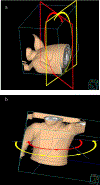Postmastectomy radiotherapy for left-sided breast cancer patients: Comparison of advanced techniques
- PMID: 31129035
- PMCID: PMC6874719
- DOI: 10.1016/j.meddos.2019.04.005
Postmastectomy radiotherapy for left-sided breast cancer patients: Comparison of advanced techniques
Abstract
Postmastectomy radiotherapy (PMRT) has been shown to improve the overall survival for invasive breast cancer patients, and many advanced radiotherapy technologies were adopted for PMRT. The purpose of our study is to compare various advanced PMRT techniques including fixed-beam intensity-modulated radiotherapy (IMRT), non-coplanar volumetric modulated arc therapy (NC-VMAT), multiple arc VMAT (MA-VMAT), and tomotherapy (TOMO). Results of standard VMAT and mixed beam therapy that were published by our group previously were also included in the plan comparisons. Treatment plans were produced for nine PMRT patients previously treated in our clinic. The plans were evaluated based on planning target volume (PTV) coverage, dose homogeneity index (DHI), conformity index (CI), dose to organs at risk (OARs), normal tissue complication probability (NTCP) of pneumonitis, lifetime attributable risk (LAR) of second cancers, and risk of coronary events (RCE). All techniques produced clinically acceptable PMRT plans. Overall, fixed-beam IMRT delivered the lowest mean dose to contralateral breast (1.56 ± 0.4 Gy) and exhibited lowest LAR (0.6 ± 0.2%) of secondary contralateral breast cancer; NC-VMAT delivered the lowest mean dose to lungs (7.5 ± 0.8 Gy), exhibited lowest LAR (5.4 ± 2.8%) of secondary lung cancer and lowest NTCP (2.1 ± 0.4%) of pneumonitis; mixed beam therapy delivered the lowest mean dose to heart (7.1 ± 1.3 Gy) and exhibited lowest RCE (8.6 ± 7.1%); TOMO plans provided the most optimal target coverage while delivering higher dose to OARs than other techniques. Both NC-VMAT and MA-VMAT exhibited lower values of all OARs evaluation metrics compare to standard VMAT. Fixed-beam IMRT, NC-VMAT, and mixed beam therapy could be the optimal radiation technique for certain breast cancer patients after mastectomy.
Keywords: Intensity-modulated radiotherapy; Postmastectomy radiotherapy; Tomotherapy; Volumetric modulated arc therapy.
Copyright © 2019 American Association of Medical Dosimetrists. Published by Elsevier Inc. All rights reserved.
Conflict of interest statement
Conflict of interest statement
The authors have no conflicts of interest.
Figures



Similar articles
-
Evaluation of a mixed beam therapy for postmastectomy breast cancer patients: Bolus electron conformal therapy combined with intensity modulated photon radiotherapy and volumetric modulated photon arc therapy.Med Phys. 2018 Jul;45(7):2912-2924. doi: 10.1002/mp.12958. Epub 2018 May 27. Med Phys. 2018. PMID: 29749075 Free PMC article.
-
Comparison of conventional and advanced radiotherapy techniques for left-sided breast cancer after breast conserving surgery.Med Dosim. 2020 Winter;45(4):e9-e16. doi: 10.1016/j.meddos.2020.05.004. Epub 2020 Jul 7. Med Dosim. 2020. PMID: 32646715 Free PMC article.
-
A dosimetric and radiobiological evaluation of VMAT following mastectomy for patients with left-sided breast cancer.Radiat Oncol. 2021 Sep 6;16(1):171. doi: 10.1186/s13014-021-01895-2. Radiat Oncol. 2021. PMID: 34488817 Free PMC article.
-
Hybrid Treatment Planning for Chest Wall Irradiation Utilizing Three-Dimensional Conformal Radiotherapy (3DCRT), Intensity-Modulated Radiation Therapy (IMRT), and Volumetric Modulated Arc Therapy (VMAT): A Systematic Review.Cureus. 2024 May 3;16(5):e59583. doi: 10.7759/cureus.59583. eCollection 2024 May. Cureus. 2024. PMID: 38832195 Free PMC article. Review.
-
Late effects arising from volumetric modulated arc therapy to the breast: A systematic review.Radiography (Lond). 2021 May;27(2):650-653. doi: 10.1016/j.radi.2020.08.003. Epub 2020 Aug 17. Radiography (Lond). 2021. PMID: 32819824
Cited by
-
A dose planning study for cardiac and lung dose sparing techniques in left breast cancer radiotherapy: Can free breathing helical tomotherapy be considered as an alternative for deep inspiration breath hold?Tech Innov Patient Support Radiat Oncol. 2023 Jan 26;25:100201. doi: 10.1016/j.tipsro.2023.100201. eCollection 2023 Mar. Tech Innov Patient Support Radiat Oncol. 2023. PMID: 36798947 Free PMC article.
-
Dosimetric analysis of half-field-based VMAT with the deep inspiration breath-hold technique for left breast cancer patients following breast-conserving surgery.Front Oncol. 2024 Nov 21;14:1418723. doi: 10.3389/fonc.2024.1418723. eCollection 2024. Front Oncol. 2024. PMID: 39640275 Free PMC article.
-
Auxiliary Structures-Assisted Radiotherapy Improvement for Advanced Left Breast Cancer.Front Oncol. 2021 Jul 8;11:702171. doi: 10.3389/fonc.2021.702171. eCollection 2021. Front Oncol. 2021. PMID: 34367986 Free PMC article.
-
Artificial Intelligence-Based Automated Treatment Planning of Postmastectomy Volumetric Modulated Arc Radiotherapy.Front Oncol. 2022 Apr 25;12:871871. doi: 10.3389/fonc.2022.871871. eCollection 2022. Front Oncol. 2022. PMID: 35547874 Free PMC article.
-
A dosiomics model for prediction of radiation-induced acute skin toxicity in breast cancer patients: machine learning-based study for a closed bore linac.Eur J Med Res. 2024 May 12;29(1):282. doi: 10.1186/s40001-024-01855-y. Eur J Med Res. 2024. PMID: 38735974 Free PMC article.
References
-
- McGale P, Taylor C, Correa C, Cutter D, Duane F, Ewertz M, Gray R, Mannu G, Peto R, Whelan T, Wang Y, Wang Z and Darby S, “Effect of radiotherapy after mastectomy and axillary surgery on 10-year recurrence and 20-year breast cancer mortality: meta-analysis of individual patient data for 8135 women in 22 randomised trials,” Lancet 383, 2127–2135 (2014). - PMC - PubMed
-
- Wang J, Li X, Deng Q, Xia B, Wu S, Liu J and Ma S, “Postoperative radiotherapy following mastectomy for patients with left-sided breast cancer: A comparative dosimetric study,” Med Dosim 40, 190–194 (2015). - PubMed
-
- Ashenafi M, Boyd RA, Lee TK, Lo KK, Gibbons JP, Rosen II, Fontenot JD and Hogstrom KR, “Feasibility of postmastectomy treatment with helical TomoTherapy,” Int J Radiat Oncol Biol Phys 77, 836–842 (2010). - PubMed
Publication types
MeSH terms
Grants and funding
LinkOut - more resources
Full Text Sources
Medical
Miscellaneous

